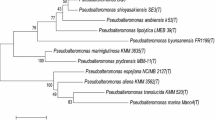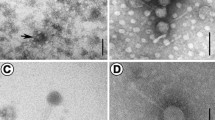Abstract
Phage PH357, a novel lytic Pseudoalteromonas lipolytica phage belonging to the Myoviridae family was isolated from the Yangtze River estuary. The microbiological characterization demonstrated that phage PH357 is stable from −20 to 60 °C and the optimal pH 7. The one-step growth curve showed a latent period of 20 min, a rise period of 20 min, and the average burst size was about 85 virions per cell. Complete genome of phage PH357 was determined. Genome of phage PH357 consisted of a linear, double-stranded 136,203 bp DNA molecule with 34.58% G + C content, and 242 putative open reading frames (ORFs) without tRNA. All the predicted ORFs were classified into eight functional groups, including DNA replication, regulation and nucleotide metabolism, transcription, translation, phage packaging, phage structure, lysis, host or phage interactions, and hypothetical protein. A phylogenetic analysis showed that phage PH357 had similarity to the previously published Pseudoalteromonas phage PH101 and Vibrio phages. Furthermore, the study of phage PH357 genome will provide useful information for further research on the interaction between phages and their hosts.






Similar content being viewed by others
References
Bai Q, Zhang W, Yang Y, Tang F, Nguyen X, Liu G, Lu C (2013) Characterization and genome sequencing of a novel bacteriophage infecting streptococcus agalactiae with high similarity to a phage from streptococcus pyogenes. Adv Virol 158(8):1733–1741
Boetzer M, Pirovano W (2012) Toward almost closed genomes with GapFiller. Genom Biol 13:R56
Bowman JP (2007) Bioactive compound synthetic capacity and ecological significance of marine bacterial genus Pseudoalteromonas. Mar Drugs 5(4):220–241
Cai L, Zhang R, He Y, Feng X, Jiao N (2016) Metagenomic analysis of Virioplankton of the subtropical Jiulong river estuary, China. Viruses 8(2):35
Capra ML, Quiberoni A, Reinheimer JA (2004) Thermal and chemical resistance of Lactobacillus casei and Lactobacillus paracasei bacteriophages. Lett Appl Microbiol 38(6):499–504
Colangelo-Lillis JR, Deming JW (2013) Genomic analysis of cold-active Colwelliaphage, 9A and psychrophilic phage–host interactions. Extremophiles 17(1):99–114
Duhaime MB, Wichels A, Waldmann J, Teeling H, Glöckner FO (2011) Ecogenomics and genome landscapes of marine Pseudoalteromonas phage H105/1. ISME J 5(1):107–121
Fuhrman JA (1999) Marine viruses and their biogeochemical and ecological effects. Nature 399(6736):541–548
Goldsmith DB, Crosti G, Dwivedi B, Dwivedi B, McDaniel LD, Varsani A, Suttle CA, Weinbauer MG, Sandaa RA, Breitbart M (2011) Development of phoH as a novel signature gene for assessing marine phage diversity. Appl Environ Microbiol 77(21):7730–7739
Huang GT, Le S, Peng YZ, Zhao Y, Yin SP, Zhang L, Yao X, Tan Y, Li M, Hu FQ (2013) Characterization and genome sequencing of phage Abp1, a new phiKMV-like virus infecting multidrug-resistant Acinetobacter baumannii. Curr Microbiol 66:535–543
Hyman P, Abedon ST (2010) Bacteriophage host range and bacterial resistance. Adv Appl Microbiol 70:217–248
Kallies R, Kiesel B, Schmidt M, Kacza J, Ghanem N, Narr A, Zopfi J, Wick LY, Hackermüller J, Harms H, Chatzinotas A (2017) Complete genome sequence of Pseudoalteromonas phage vB_PspS-H40/1 (formerly H40/1) that infects Pseudoalteromonas sp. strain H40 and is used as biological tracer in hydrological transport studies. Stand Genom Sci 12(1):20
Kropinski AM, Waddell T, Meng J, Franklin K, Ackermann HW, Ahmed R, Mazzocco A, Yates J, Lingohr EJ, Johnson RP (2013) The host-range, genomics and proteomics of Escherichia coli, O157:H7 bacteriophage rV5. Virol J 10(1):1–12
Li E, Xiao W, Ma Y, Zhe Y, Li H, Lin W, Wang X, Li C, Shen Z, Zhao R, Yang H, Jiang A, Yang W, Yuan J, Zhao X (2016) Isolation and characterization of a bacteriophage phieap-2 infecting multidrug resistant enterobacter aerogenes. Sci Rep 6:28338
Li P, Chen BB, Song Z, Song Y, Yang Y, Ma P, Wang H, Ying J, Ren P, Yang Y, Gao G, Jin S, Bao Q, Yang H (2012) Bioinformatic analysis of the Acinetobacter baumannii phage AB1 genome. Gene 507(2):125–134
Li Y, Wang M, Liu Q, Song X, Wang D, Ma Y, Jiang Y (2016) Complete genomic sequence of bacteriophage H188: a novel Vibrio kanaloae phage isolated from yellow sea. Curr Microbiol 72(5):628–633
Liu SB, Chen XL, He HL, Zhang XY, Xie BB, Yu Y, Zhang YZ (2013) Structure and ecological roles of a novel exopolysaccharide from the Arctic sea ice bacterium Pseudoalteromonas sp. strain SM20310. Appl Environ Microbiol 79(1):224–230
Massouras A, Hens K, Gubelmann C, Uplekar S, Decouttere F, Rougemont J, Cole ST, Deplancke B (2010) Primer-initiated sequence synthesis to detect and assemble structural variants. Nat Methods 7:6–485
Middelboe M, Chan A, Bertelsen SK (2010) Isolation and life-cycle characterization of lytic viruses infecting heterotrophic bacteria and cyanobacteria. Man Aquat Viral Ecol 13:118–133
Poli A, Anzelmo G, Nicolaus B (2010) Bacterial exopolysaccharides from extreme marine habitats: production, characterization and biological activities. Mar Drugs 8(6):1779–1802
Qin QL, Li Y, Zhang YJ, Zhou ZM, Zhang WX, Chen XL, Zhang YZ (2011) Comparative genomics reveals a deep-sea sediment-adapted life style of Pseudoalteromonas sp. SM9913. ISME J 5(2):274–284
Rao VB, Feiss M (2008) The bacteriophage DNA packaging motor. Annu Rev Genet 42:647–681
Saitou N, Nei M (1987) The neighbor–joining method: a new method for reconstructing phylogenetic trees. Mol Biol Evol 4:406–425
Senčilo A, Luhtanen AM, Saarijärvi M, Bamford DH, Roine E (2015) Cold-active bacteriophages from the baltic sea ice have diverse genomes and virus–host interactions. Environ Microbiol 17(10):392–400
Suttle CA (2005) Viruses in the sea. Nature 437(7057):356–361
Wang DB, Sun MQ, Shao HB, Li Y, Meng X, Liu ZY, Wang M (2015) Characterization and genome sequencing of a novel bacteriophage PH101 infecting Pseudoalteromonas marina BH101 from the yellow sea of China. Curr Microbiol 71(5):594–600
Wang P, Yu Z, Li B, Cai X, Zeng Z, Chen X, Wang X (2015) Development of an efficient conjugation-based genetic manipulation system for Pseudoalteromonas. Microb Cell Fact 14(1):1
Wang W, Li M, Lin H, Wang J, Mao X (2016) The Vibrio parahaemolyticus-infecting bacteriophage qdvp001: genome sequence and endolysin with a modular structure. Adv Virol 161(10):2645–2652
Wichels A, Biel SS, Gelderblom HR, Brinkhoff T, Muyzer G, Schütt C (1998) Bacteriophage diversity in the North Sea. Appl Environ Microbiol 64(11):4128–4133
Xu J, Hendrix RW, Duda RL (2004) Conserved translational frameshift in dsDNA bacteriophage tail assembly genes. Mol Cell 16:11–21
Xu XW, Wu YH, Wang CS, Gao XH, Wang XG, Wu M (2010) Pseudoalteromonas lipolytica sp. nov., isolated from the Yangtze River estuary. Int J Syst Evol Microbiol 60(9):2176–2181
Yu ZC, Chen XL, Shen QT, Zhao DL, Tang BL, Su HN, Wu ZY, Qin QL, Xie BB, Zhang XY, Yu Y (2015) Filamentous phages prevalent in Pseudoalteromonas spp. confer properties advantageous to host survival in Arctic sea ice. ISME J 9(4):871–881
Yuan L, Cui Z, Wang Y, Guo X, Zhao Y (2014) Complete genome sequence of virulent bacteriophage shou24, which infects foodborne pathogenic vibrio parahaemolyticus. Adv Virol 159(11):3089–3093
Zeng Z, Guo XP, Li B, Wang P, Cai X, Tian X, Wang X (2015) Characterization of self-generated variants in Pseudoalteromonas lipolytica biofilm with increased antifouling activities. Appl Microbiol Biotechnol 99(23):10127–10139
Acknowledgements
The authors greatly appreciate the officers, crew, and scientific staff onboard the research vessel Dong Fang Hong 2 for facilitating the collection of the seawater samples.
Funding
This work was supported by the National Natural Science Foundation of China (NSFC Grant Nos. 31500339, 41676178, 41076088), the National Key Basic Research Program of China (973Program, Grant No: 2013CB429704), China Postdoctoral Science Foundation (Grant Nos. 2015M570612 and 2016T90649), and Fundamental Research Funds for the Central University of Ocean University of China (Grant Nos. 201564010 and 201512008).
Author information
Authors and Affiliations
Corresponding authors
Ethics declarations
Conflict of interest
The authors declare that they have no conflict of interest regarding this study.
Ethical Approval
This article does not contain any studies with human participants or animals performed by any of the authors.
Electronic Supplementary Material
Below is the link to the electronic supplementary material.
Rights and permissions
About this article
Cite this article
Gong, Z., Wang, M., Yang, Q. et al. Isolation and Complete Genome Sequence of a Novel Pseudoalteromonas Phage PH357 from the Yangtze River Estuary. Curr Microbiol 74, 832–839 (2017). https://doi.org/10.1007/s00284-017-1244-8
Received:
Accepted:
Published:
Issue Date:
DOI: https://doi.org/10.1007/s00284-017-1244-8




